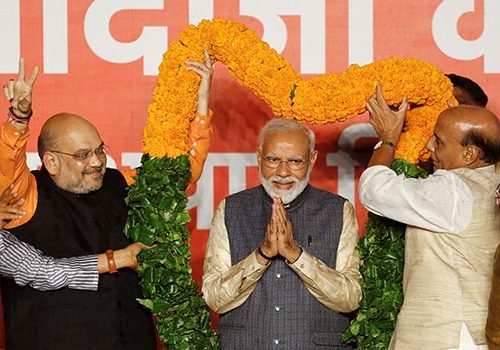India’s Minister for Commerce and Industry, Piyush Goyal, last week informed parliament that his government was in the process of finalizing a beta version of an Open Network for Digital Commerce (ONDC). He further added that an ONDC will “give opportunity for small retailers to stand up in competition against big companies.” These comments suggest that the ONDC is the latest government-backed open network initiative that seeks to digitize the country’s economy while ensuring that the digital economy is not dominated by large, predominantly foreign entities.
To understand why the government is pushing for the ONDC, it is important to understand three underlying factors that are shaping India’s burgeoning digital economy:
- The impetus for self-reliance and growing techlash
- Pushback against alleged uncompetitive behavior of large, foreign owned e-commerce companies
- Mission-mode adoption of open digital ecosystems across key sectors
Before diving into these key factors, it is important to understand the ONDC’s technical details. The ONDC was launched in July 2021 by the Department of Promotion of Industry and Internal Trade (DPIIT), which is overseen by Minister Goyal’s Commerce Ministry. It is envisaged as an open source platform to digitize the entire value chain of e-commerce through an open network that will not be owned or controlled by a single entity or platform. The idea is to connect buyers, suppliers, payment providers, and logistics service providers on an ecosystem, based on an open-source methodology, using open specifications and open network protocols.
The ONDC seeks to turn the traditional e-commerce model on its head. The current model relies on an intermediary or a direct seller that controls choices and terms for buyers (or sellers if it is an intermediary). Instead, the government wants to decentralize e-commerce by unbundling an e-commerce transaction, allowing buyers or sellers to exercise their choice at every step. This, in the government’s view, will help achieve interoperability between platforms, allowing buyers and sellers to transact irrespective of the platform/application used by them.
The principle behind the ONDC is consistent with the key principle of all open source movements, software, and applications: from platforms to protocols. This is how the internet works. We can email each other across applications run by Google and Microsoft because email protocols are interoperable, making email platform-independent. However, this interoperability is not possible across the digital domain. We cannot message from WhatsApp to Telegrams or iMessage, and this interoperability is similarly unavailable in e-commerce.
The ONDC wants to give Indian consumers this choice. It is being built on the Beckn Protocol, a set of open, interoperable specifications. Through this protocol, a typical e-commerce transaction on the ONDC will involve a buyer searching for a good on an app that is connected to it. Buyers will be directed to products listed across connected apps and sellers (through a multi-domain registry). As the buyer selects the order, the registry will again search for delivery partners, which can be chosen by the buyer and who can then proceed to complete the transaction by choosing the most optimal payment options. In each of these steps, the buyer will have the choice to interact with any players along these layers who also are not exclusively bound to a single platform.
ONDC architects believe that this maximizes choices for all parties involved in the transaction and prohibits a single company from exercising undue control. The creators believe the model can be replicated across sectors where platform businesses thrive, such as retail (including wholesale), food delivery, travel, hospitality, mobility, and tourism.
Now that the how is clear, it is important to understand why India wants to undertake this mammoth technical exercise. A key driver is India’s push for self-reliance across sectors: as global supply chains broke down due to disruptions caused by the COVID-19 outbreak in 2020, Indian Prime Minister Narendra Modi announced an ambitious Atmanirbhar Bharat, or “Self-Reliant India,” agenda. However, the push for self-reliance existed in India long before Modi pushed this slogan. India wants to push domestic companies across sectors, including domestic manufacturing (through incentives to foreign players to localize) and domestic suppliers in public procurement through various “Make in India” public procurement orders.
In the case of the digital economy, the reasons and policy mechanisms become more complicated for the self-reliant push. India is part of numerous countries that are pushing back against the growing influence of large tech companies. This techlash is primarily fueled by global examples that showcase the power of these companies to shape a country’s society, economy, and politics. In the past few years, almost all global tech companies like Facebook (now Meta), Twitter, Mastercard, Amazon, and others, have faced multiple incidences of scrutiny from Indian authorities. It can be argued that in some cases this scrutiny was unwarranted.
Nevertheless, because of this growing techlash, the Indian government is pursuing a whole host of new policy measures to regulate these tech companies. This includes new regulations for social media intermediaries and over-the-top (OTT) platforms, a draft Data Protection Bill to regulate both personal and non-personal data, and a draft national e-commerce policy that goes beyond e-commerce issues, among others. A National Cybersecurity Strategy and a revision to the country’s foundational Information Technology Act may also be on the cards in the near future. Control over data is a crucial force behind all these policies as parts of the government believe that these companies have taken undue advantage of the data generated by Indian citizens. This is why data localization is a key common component across sectoral policies, and several policies and initiatives are aimed at helping the Indian government and businesses benefit from the economic aspects of data. Several stakeholders term data as the new oil and believe the country is not benefitting from the vast troves of data that its citizens generate. This data fuels the creation, optimization, and improvement of products that companies generate. Timely access to data for law enforcement purposes is also bolstering the demands for data localization. The belief is that the development of indigenous technology will help to address these issues, which is a key belief driving initiatives like the ONDC.
Another key factor driving the ONDC is the government’s continuous pushback against the two largest global retailers–Amazon and Walmart (which owns Flipkart, India’s largest e-commerce platform). E-commerce is one of India’s most heavily scrutinized sectors from a policy perspective. This is partly due to India’s complex regulations for e-commerce: India allows 100 percent FDI in business-to-business (B2B) e-commerce. In business-to-consumer (B2C) e-commerce, 100 percent of FDI is permitted in single-brand retail trade (SBRT) e-commerce and only marketplace models for multi-brand retail B2C e-commerce. FDI in B2C multi-brand retail e-commerce for inventory-based models is not allowed.
It has been alleged by India’s large trading community and Indian companies that global companies are utilizing loopholes in the policies to formulate complicated structures to run inventory-based multi-brand retail B2C e-commerce models, which is against the spirit and letter of the law. The dominance of foreign players in the sector and concentration of power within a few platforms has been a thorny issue, with both economic and political relevance. Minister Goyal has criticized these companies on numerous occasions and has had heated discussions with them. He has even called them “arrogant” and backed the demands for a strict probe against them. The public spats have turned from bad to ugly: when Jeff Bezos visited India in 2020, he could not meet the prime minister, a move seen as India openly showing its displeasure against large e-commerce firms. But more than the displeasure, these censures against Amazon and Flipkart are about pleasing the ruling Bharatiya Janata Party’s most prominent political supporters: India’s trading community, a traditional vote bank for the party.
The government believes that local solutions for the ‘e-commerce problem’ will also boost India’s small trading community and lead to the rapid digitization of India’s retail infrastructure and resources. The advisory council formed for the ONDC originally featured Mr. Praveen Khandelwal, the General Secretary of Confederation of All India Traders (CAIT), but he recently resigned from the council citing “moral and ethical grounds and to avoid any conflict of interest.”
The third and most important factor driving the growth of the ONDC and open digital ecosystems in India is the past success of several similar initiatives. India has successfully rolled out Aadhaar, the world’s largest biometric identification system. Despite concerns around privacy and security by digital activists, Aadhaar has fundamentally transformed the public service delivery system in India. Envisaged as a foundational identity card (Aadhaar in Hindi means “foundation”), it now forms the backbone of various government initiatives, financial inclusion measures, welfare programs, and tax collection. The Unified Payments Interface (UPI), launched after Aadhaar, transformed financial transactions in India. The UPI platform, anchored by the National Payments Corporation of India (NPCI), has revolutionized cost-effective and speedy real-time digital payments.
UPI has given birth to a vibrant community of both public and private actors in financial services, such as the mobile wallet Payment Service Providers (PSP), who are building solutions in mobile-based e-commerce, bill payments, and real-time payments. In December 2021 alone, UPI recorded 4.56 billion transactions worth INR 8.27 trillion. A similarly modeled sales tax platform is the backbone of India’s indirect tax regime. Similar initiatives in health, education, agriculture, urban governance, and other sectors are in various stages of rollout. The Indian government has also released several strategic papers to guide the creation of these “open ecosystems” and their architecture. All these initiatives are interlinked and can potentially disrupt existing business models. The success of these initiatives has also prompted the government to look at them as tools for tech diplomacy where India-made solutions can be replicated in other countries: India’s UPI is all set to go global and the others might follow after achieving scale.
The common denominator in all these initiatives is India’s pioneer in the information technology sector, Nandan Nilekani, who is the founder and current non-executive chairman of Infosys. He served as the founding chairman of the government agency that created Aadhaar. Nilekani is also one of the ONDC’s key backers and part of the advisory council set up to create it. In a recent public interaction, he compared the ONDC and UPI and said he expects its implementation to be rapid since it will build on the knowledge of the existing transformational projects. He further emphasized that the ONDC has all the ingredients and attributes that contributed to the success of the past projects. According to Nilekani, it will enable small sellers to participate in high-growth digital commerce while expanding the market dramatically.
The architects of the ONDC insist that the platform will not cannibalize the existing e-commerce ecosystem. Instead, it seeks to transform and revolutionize the entire e-commerce value chain that will lead to more players joining, improving efficiency, and growing the size of the e-commerce market, just like UPI did for the fintech market. Detractors disagree and point out that e-commerce transactions are extremely different from digital financial transactions. The e-commerce experience is built on forward and backward linkages that include a wide selection of products, seamless delivery (including returns), grievance redressal mechanisms, and others. They argue that it is difficult to imagine how an open system without a central figure will be able to provide a similar experience. Therefore, the challenge for the ONDC is to go beyond creating the “open network” which can only be a start to revolutionize the sector. The detractors also raise concerns about the governance of all these open ecosystem initiatives since they are being developed and run by nonprofits/volunteers who are entrusted with immense responsibility but with limited accountability.
Though it is still early, we must watch the ONDC closely since it may fundamentally transform India’s e-commerce and platform economy. A use case of the Beckn protocol (which powers ONDC) is already running in the Indian city of Kochi. The metropolitan authority is running a ride-hailing app Yatri based on the protocol, where drivers do not have to pay a commission to the app. Implementing this on a mass scale across sectors is not going to be easy. The ONDC undoubtedly has a complicated problem at its disposal. However, Nilekani (and his team) have a history of solving seemingly unsolvable problems over the last decade, contributing to India’s growth and development.
Adnan Ahmad Ansari is a policy analyst with an educational background in engineering and liberal arts. He is currently an Associate Vice President at 9.9 Insights, a Policy and Strategic Advisory firm based out of New Delhi, India. Views are his personal.

The South Asia Center is the hub for the Atlantic Council’s analysis of the political, social, geographical, and cultural diversity of the region. At the intersection of South Asia and its geopolitics, SAC cultivates dialogue to shape policy and forge ties between the region and the global community.
Related content
Image: 3D rendering of a digital key with binary code entering into an abstract lock (Mott Jordan/ShutterStock)



